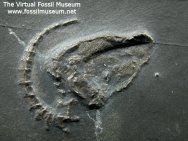Name: Mitrata:
Dalejocystis (Mitrocystites) styloideus
Age: Lower
Devonian Seigenian/Emsian Stage
Size (25.4mm=1
inch): 12 mm by 8 mm with 15 mm “tail” on a 135 by 120 mm
matrix
Location:
Hunsruck Slate, Bundenbach Germany
 Description:
Well-preserved example of a mitrate carpoid known as Dalejocystis
(Mitrocystites) styloideus. The term mitrate derives from the carpoid’s
shape that is similar to a bishop’s mitre. The Hunsruck slate
is famous Description:
Well-preserved example of a mitrate carpoid known as Dalejocystis
(Mitrocystites) styloideus. The term mitrate derives from the carpoid’s
shape that is similar to a bishop’s mitre. The Hunsruck slate
is famous  for
its fossils, many of which have pyritization present. Rapid burial
and pyritization was what led to the many wonderful examples of early
Devonian life from the region. The mudstones were metamorphosed into
slate during the Carboniferous. The slate was quarried for roofing
tiles, and the quarrymen would save the fossils for later sale. Now
that the quarries are no longer open, future supplies of these wonderfully
preserved benthic organisms will only come from existing collections.
A skeleton of calcitic plates like those found in modern Echinoderms
supported the carpoid body. They had a spiny “tail” by
which they are thought to have pushed their way through the muddy
bottom. Some believe that a carpoid may have been the common ancestor
between Echinoderms and Vertebrates. It is important to note the carpoids
differ from ALL other animals, living and extinct, in that many are
completely asymmetrical. This enigmatic fossil is rarely so well prepared
(this one was done by Wouter Sudkamp). Notice the fine details and
the pyrite highlights, making this a spectacular example. for
its fossils, many of which have pyritization present. Rapid burial
and pyritization was what led to the many wonderful examples of early
Devonian life from the region. The mudstones were metamorphosed into
slate during the Carboniferous. The slate was quarried for roofing
tiles, and the quarrymen would save the fossils for later sale. Now
that the quarries are no longer open, future supplies of these wonderfully
preserved benthic organisms will only come from existing collections.
A skeleton of calcitic plates like those found in modern Echinoderms
supported the carpoid body. They had a spiny “tail” by
which they are thought to have pushed their way through the muddy
bottom. Some believe that a carpoid may have been the common ancestor
between Echinoderms and Vertebrates. It is important to note the carpoids
differ from ALL other animals, living and extinct, in that many are
completely asymmetrical. This enigmatic fossil is rarely so well prepared
(this one was done by Wouter Sudkamp). Notice the fine details and
the pyrite highlights, making this a spectacular example. |
|